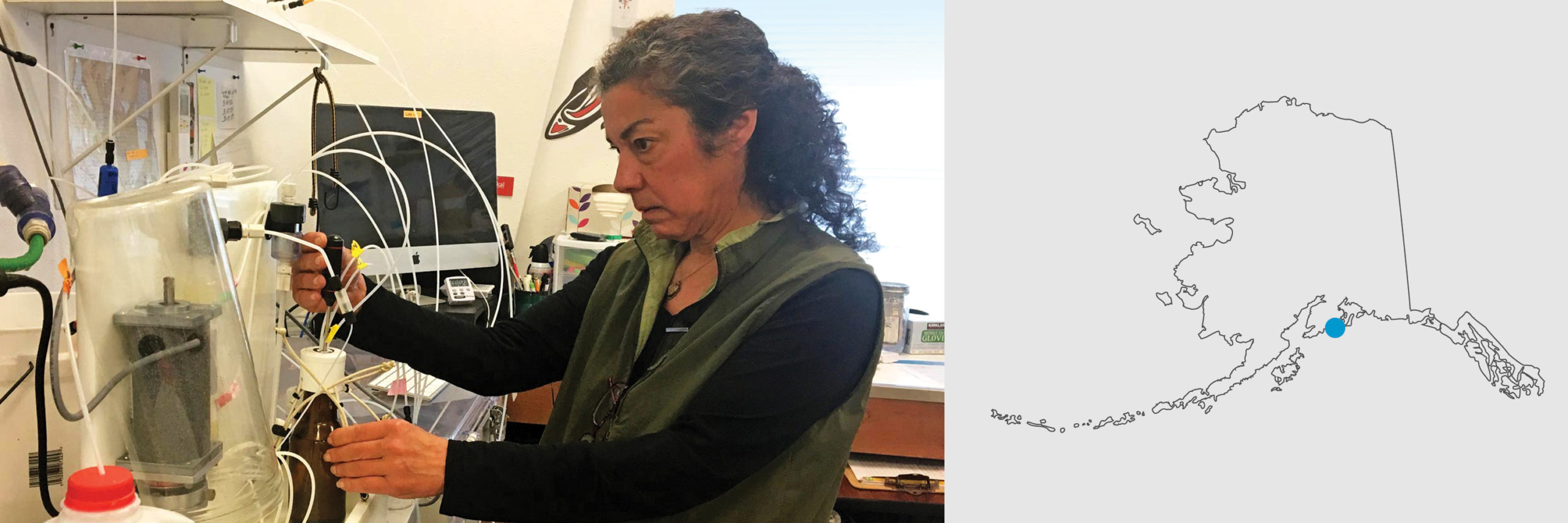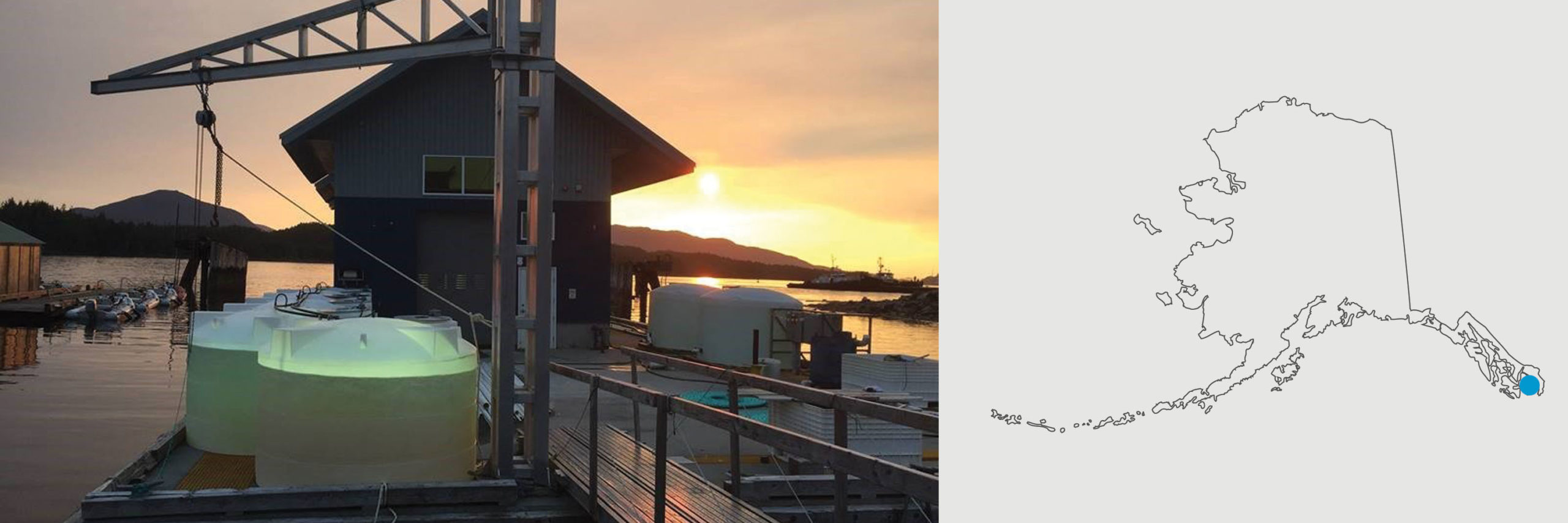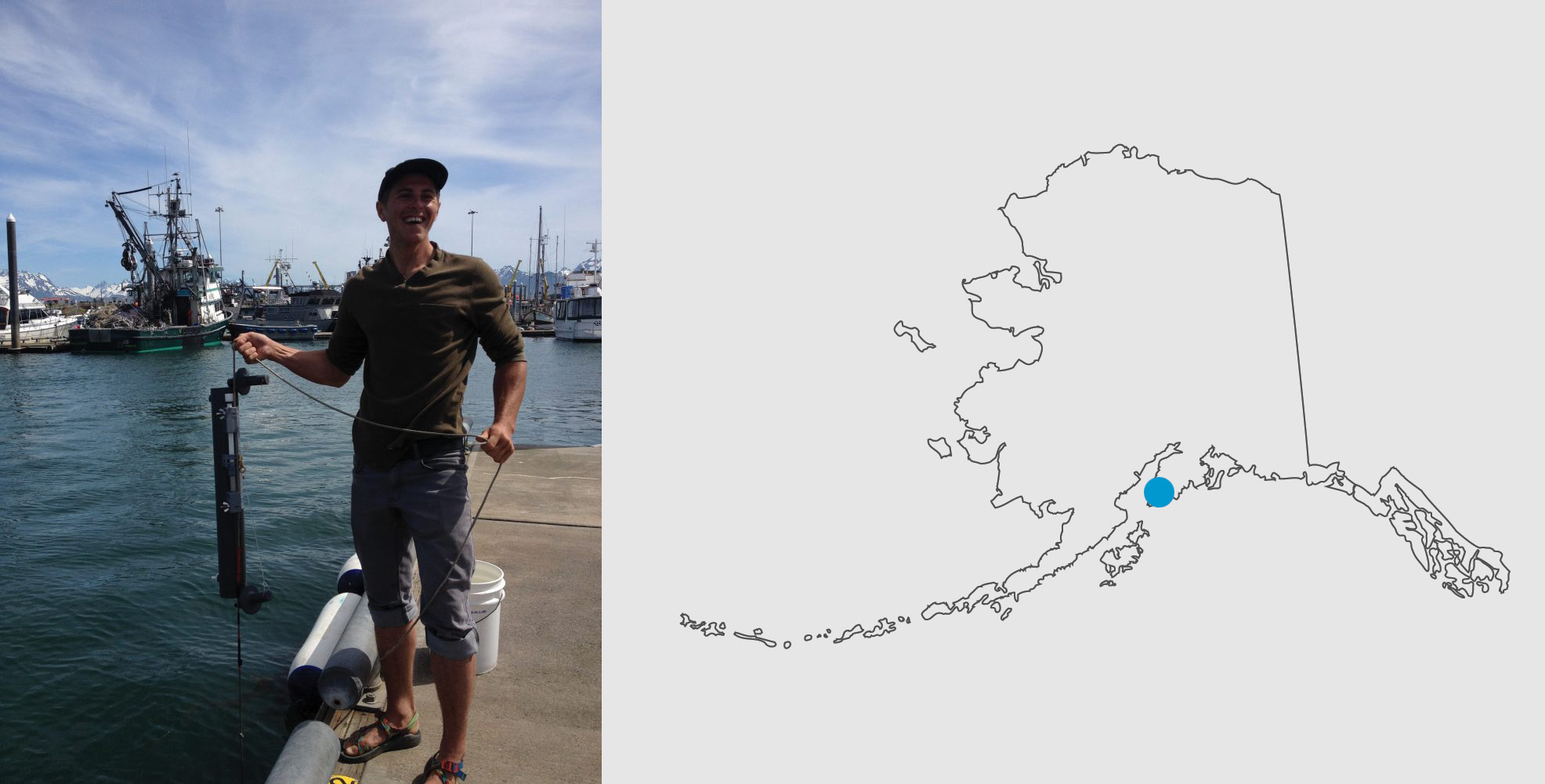Shore-Based Stations
Alutiiq Pride Marine Institute Burke-o-Lator
Location: Alutiiq Pride Marine Institute, Seward
Timeline: August 2014 to present
Description: This monitoring system in Seward is part of the IOOS Pacific Region Ocean Acidification Network (IPACOA) that links seven similar sites across along the Pacific coast of North America. The Burke-o-Lator systems were invented by Burke Hales from Oregon State University. The Alutiiq Pride Burke-o-Lator is maintained by Wiley Evans from the Hakai Institute and Jacqueline Ramsay from Alutiiq Pride Marine Institute.
The Burke-O-Lator measures several different ocean acidification parameters of sea water using a flow-through system at the hatchery.
Principal Investigator: Wiley Evans, Hakai Institute
Funding and Support Sources: Alaska Ocean Observing System (AOOS), Northwest Associations of Networked Ocean Observing Systems (NANOOS), Hakai Institute, NOAA Ocean Acidification Program, Oregon State University (OSU) College of Earth, Ocean and Atmospheric Sciences , UAF Ocean Acidification Research Center (OARC).
OceansAlaska Burke-o-Lator
Location: OceansAlaska facility, Ketchikan
Timeline: Operational 2016- 2019. Expected to resume 2022.
Description: This monitoring system is part of the IOOS Pacific Region Ocean Acidification Network (IPACOA) that links seven similar sites along the Pacific coast of North America. The Burke-o-Lator systems were invented by Burke Hales from Oregon State University. The OceansAlaska Burke-o-Lator is maintained by Wiley Evans from the Hakai Institute.
OceansAlaska is a shellfish hatchery located in Ketchikan. It is the only site in the state that produces oyster seeds and makes them available to other growers.
Instrumentation: The Burke-O-Lator pCO2/TCO2 analyzer measures carbon dioxide partial pressure (pCO2) and total dissolved inorganic carbon (TCO2) both continuously from a flow-through seawater stream and from seawater collected in discrete samples.
The Burke-O-Lator is a series of sensors driven by a computer using custom LabVIEW software to control, capture and log the measurements made by the system. Measurements of seawater temperature and salinity are also made in conjunction with measured pCO2 and TCO2. Using these four parameters, the saturation state or aragonite (the most soluble form of calcium carbonate) and pH are determined in real-time. Both the pCO2 and TCO2 measurements are made using non-dispersive infrared (NDIR) technology (LI-COR LI-840A). pCO2 and TCO2 measurements are run sequentially, with the Burke-O-Lator first sampling carrier gas (room air) equilibrated with flowing seawater in the equilibrator to determine the pCO2 continuously for roughly 57 minutes. During the last 3 minutes of the hour, the Burke-O-Lator transitions to sample carrier gas that has captured the evolvedCO2 from a small acidified seawater volume to determine the TCO2. For discrete sample processing, the measurements are the same except headspace gas and sample volume are drawn from the sample bottle rather than the equilibrator and flow-through seawater stream.
Principal Investigator: Wiley Evans, Hakai Institute
Funding and Support Sources: Alaska Ocean Observing System (AOOS) and the Northwest Associations of Networked Ocean Observing Systems (NANOOS). Equipment purchased by the UAF Ocean Acidification Research Center.
Sitka Tribe of Alaska Burke-o-Lator
Location: Sitka, Alaska
Timeline: June 2017 – present
Description: The STA Burke-o-Lator (BoL) continuously monitors the carbonate chemistry of Sitka’s harbor channel. This instrument also analyzes discrete, near-shore samples from shellfish sites associated with the Southeast Alaska Tribal Ocean Research (SEATOR) partnership. The STA BoL shares its continuous data with the IOOS Pacific Region Ocean Acidification Network (IPACOA) that links similar sites along the Pacific coast of North America. This Burke-o-Lator was installed by Professor Burke Hales from Oregon State University and by Dr. Wiley Evans from the Hakai Institute.
Instrumentation: The Dakunalytics Burke-O-Lator pCO2/TCO2 analyzer measures carbon dioxide partial pressure (pCO2) and total dissolved inorganic carbon (TCO2) both continuously from a flow-through seawater stream and from seawater collected in discrete samples.
The Burke-O-Lator is a series of sensors driven by a computer using custom LabVIEW software to control, capture and log the measurements made by the system. Measurements of seawater temperature and salinity are also made in conjunction with measured pCO2 and TCO2. Using these four parameters, the saturation state or aragonite (the most soluble form of calcium carbonate) and pH are determined in real-time. Both the pCO2 and TCO2 measurements are made using non-dispersive infrared (NDIR) technology (LI-COR LI-840A). pCO2 and TCO2 measurements are run sequentially, with the Burke-O-Lator first sampling carrier gas (room air) equilibrated with flowing seawater in the equilibrator to determine the pCO2 continuously for roughly 57 minutes. During the last 3 minutes of the hour, the Burke-O-Lator transitions to sample carrier gas that has captured the evolved CO2 from a small acidified seawater volume to determine the TCO2. For discrete sample processing, the measurements are the same except headspace gas and sample volume are drawn from the sample bottle rather than the equilibrator and flow-through seawater stream.
Principal Investigators: Esther Kennedy, Sitka Tribe of Alaska; Wiley Evans, Hakai Institute
Funding Source: BIA Climate Change grant
Continuous Data Support: Willey Evans, Hakai Institute
Kodiak Burke-o-Lator
Location: NOAA Kodiak Laboratory
Timeline: Installed October 2017.
Description: This system is the latest shore-based monitoring site in Alaska and is owned by UAF’s Ocean Acidification Research Center. The Kodiak BoL shares its continuous data with the IOOS Pacific Region Ocean Acidification Network (IPACOA) that links similar sites along the Pacific coast of North America. This Burke-o-Lator is maintained by Switgard Duesterloh at the NOAA Kodiak Lab and Dr. Wiley Evans from the Hakai Institute.
The NOAA Kodiak Laboratory is part of the Alaska Fisheries Science Center and is located in the Kodiak Fisheries Research Center.
Instrumentation: The Dakunalytics Burke-O-Lator pCO2/TCO2 analyzer measures carbon dioxide partial pressure (pCO2) and total dissolved inorganic carbon (TCO2) both continuously from a flow-through seawater stream and from seawater collected in discrete samples.
The Burke-O-Lator is a series of sensors driven by a computer using custom LabVIEW software to control, capture and log the measurements made by the system. Measurements of seawater temperature and salinity are also made in conjunction with measured pCO2 and TCO2. Using these four parameters, the saturation state or aragonite (the most soluble form of calcium carbonate) and pH are determined in real-time. Both the pCO2 and TCO2 measurements are made using non-dispersive infrared (NDIR) technology (LI-COR LI-840A). pCO2 and TCO2 measurements are run sequentially, with the Burke-O-Lator first sampling carrier gas (room air) equilibrated with flowing seawater in the equilibrator to determine the pCO2 continuously for roughly 57 minutes. During the last 3 minutes of the hour, the Burke-O-Lator transitions to sample carrier gas that has captured the evolvedCO2 from a small acidified seawater volume to determine the TCO2. For discrete sample processing, the measurements are the same except headspace gas and sample volume are drawn from the sample bottle rather than the equilibrator and flow-through seawater stream.
Principal Investigator: Robert Foy, NOAA Kodiak Laboratory
Funding Sources: NOAA Ocean Acidification Program, UAF Ocean Acidification Research Center, State of Alaska, Alaska Ocean Observing System (AOOS).
Kachemak Bay Research Reserve Stations
Location: Seldovia and Homer Harbors (year-round), Bear Cove (March-Nov)
Timeline: pH probe data since 2001; water samples for carbonate chemistry 2016. Note:Carbonate chemistry needs to be established for the region before aragonite saturation algorithms can be established.
Description: Ocean acidification was identified by local and regional stakeholders as an important issue in south central Alaska for subsistence & recreational food sources. Local stakeholders were also concerned that we do not have baseline information to help inform how ocean acidification will transform the local near shore ecology of the region (KBNERR Bivalve Proceedings 2014). The complexity of ocean chemistry in estuaries has led to this important habitat being omitted, thus far, from strategies developed for monitoring ocean acidification in Alaska. The KBNERR has a long-term monitoring program that can support and help direct additional monitoring and research into the complex nature of ocean acidification in estuary habitats in south-central Alaska.
Through our existing programs and partnerships, we plan to grow this area of expertise for our region on a local, regional, national, and international scale.
Instrumentation: YSI pH sensor; water samples for carbonate chemistry at all nutrient monitoring sites.
Principal Investigator: Angie Doroff, Kachemak Bay Research Reserve (KBNERR)
Funding Sources: NOAA, KBNERR for logistic support as part of SWMP 2016.





